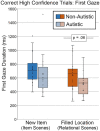Relational memory weakness in autism despite the use of a controlled encoding task
- PMID: 37691809
- PMCID: PMC10484720
- DOI: 10.3389/fpsyg.2023.1210259
Relational memory weakness in autism despite the use of a controlled encoding task
Abstract
Introduction: Recent work challenged past findings that documented relational memory impairments in autism. Previous studies often relied solely on explicit behavioral responses to assess relational memory integrity, but successful performance on behavioral tasks may rely on other cognitive abilities (e.g., executive functioning) that are impacted in some autistic individuals. Eye-tracking tasks do not require explicit behavioral responses, and, further, eye movements provide an indirect measure of memory. The current study examined whether memory-specific viewing patterns toward scenes differ between autistic and non-autistic individuals.
Methods: Using a long-term memory paradigm that equated for complexity between item and relational memory tasks, participants studied a series of scenes. Following the initial study phase, scenes were re-presented, accompanied by an orienting question that directed participants to attend to either features of an item (i.e., in the item condition) or spatial relationships between items (i.e., in the relational condition) that might be subsequently modified during test. At test, participants viewed scenes that were unchanged (i.e., repeated from study), scenes that underwent an "item" modification (an exemplar switch) or a "relational" modification (a location switch), and scenes that had not been presented before. Eye movements were recorded throughout.
Results: During study, there were no significant group differences in viewing directed to regions of scenes that might be manipulated at test, suggesting comparable processing of scene details during encoding. However, there was a group difference in explicit recognition accuracy for scenes that underwent a relational change. Marginal group differences in the expression of memory-based viewing effects during test for relational scenes were consistent with this behavioral outcome, particularly when analyses were limited to scenes recognized correctly with high confidence. Group differences were also evident in correlational analyses that examined the association between study phase viewing and recognition accuracy and between performance on the Picture Sequence Memory Test and recognition accuracy.
Discussion: Together, our findings suggest differences in the integrity of relational memory representations and/or in the relationships between subcomponents of memory in autism.
Keywords: ASD; autism; episodic memory; eye tracking; relational memory.
Copyright © 2023 Minor, Hannula, Gordon, Ragland, Iosif and Solomon.
Conflict of interest statement
The authors declare that the research was conducted in the absence of any commercial or financial relationships that could be construed as a potential conflict of interest.
Figures











Similar articles
-
Use of eye movement monitoring to examine item and relational memory in schizophrenia.Biol Psychiatry. 2010 Oct 1;68(7):610-6. doi: 10.1016/j.biopsych.2010.06.001. Epub 2010 Jul 31. Biol Psychiatry. 2010. PMID: 20673874 Free PMC article.
-
Cognitive control and episodic memory in adolescents with autism spectrum disorders.Neuropsychologia. 2016 Aug;89:31-41. doi: 10.1016/j.neuropsychologia.2016.05.013. Epub 2016 May 13. Neuropsychologia. 2016. PMID: 27184119 Free PMC article.
-
EXPRESS: Eye Movements as Indices of Spatial and Associative Memory.Q J Exp Psychol (Hove). 2024 Nov 30:17470218241307025. doi: 10.1177/17470218241307025. Online ahead of print. Q J Exp Psychol (Hove). 2024. PMID: 39614696
-
[Functioning of memory in subjects with autism].Encephale. 2008 Dec;34(6):550-6. doi: 10.1016/j.encep.2007.10.010. Epub 2008 Mar 4. Encephale. 2008. PMID: 19081450 Review. French.
-
Memory deficit in patients with schizophrenia and posttraumatic stress disorder: relational vs item-specific memory.Neuropsychiatr Dis Treat. 2016 May 10;12:1157-66. doi: 10.2147/NDT.S104384. eCollection 2016. Neuropsychiatr Dis Treat. 2016. PMID: 27274250 Free PMC article. Review.
References
-
- American Psychiatric Association . (2013). Diagnostic and Statistical Manual of Mental Disorders (5th). American Psychiatric Publishing. Washington, DC
LinkOut - more resources
Full Text Sources
Miscellaneous

